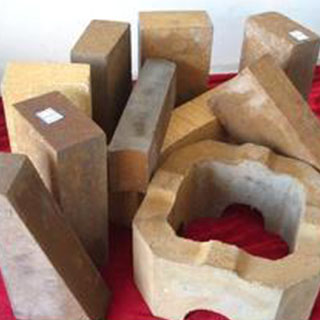Magnesia-chrome brick is an alkaline refractory product containing MgO 55%~80%, Cr2O3 8%~20%, which is composed of periclase, magnesia-zirconium brick composite spinel and a small amount of silicate phase. The composite spinel includes spinel solid solutions such as MgAl2O4, MgFe2O4, MgCr2O4 and FeAl2O4.
Magnesia-chrome bricks have developed rapidly after the 1960s due to the improvement of raw material purity and firing temperature. At present, magnesia-chrome bricks can be divided into ordinary bricks, direct-bonded bricks, co-sintered bricks, re-bonded bricks and bricks according to different production methods. Cast bricks, etc.
(1) Ordinary magnesia chrome brick
This is a traditional product, with chrome ore as coarse particles and magnesia as fine powder. Or the two materials are composed of graded particles, and the firing temperature is generally 1550-1600 °C. The microstructure of this kind of brick shows that there is little direct bond between chrome ore particles and periclase, mostly silicate (CMS) cementation or crack isolation; there are few desolubilization phases in periclase, and the matrix Rarely combined directly, this brick has poor mechanical properties and poor slag corrosion resistance.

(2) Directly bonded magnesia chrome brick
Directly combined magnesia-chrome bricks are developed on the basis of ordinary magnesia-chrome bricks. There are two main production characteristics: one is the use of purer raw materials, and the other is the use of higher firing temperatures. The so-called direct bonding means that there is more direct contact between the chrome ore particles in the brick and the periclase, because there is less SiO2 in the raw material (controlled below 1% to 25%), and the amount of silicate generated is small. The firing means squeezes the silicate into the corners of the solid phase particles. Thereby, direct binding of the solid phase is improved.
Magnesia carbon brick application
Directly bonded magnesia-chrome bricks have high high temperature strength, slag resistance, erosion resistance, erosion resistance, corrosion resistance, excellent thermal shock stability and volume stability at 1800 °C due to the high degree of direct bonding.
(3) Co-sintered magnesia-chrome bricks
The production process of this product is characterized in that the mixture of magnesia and chrome ore fine powder in a certain proportion is fired in a high-temperature furnace to achieve a solid-phase reaction for the purpose of generating secondary spinel and magnesia-chromium ore directly combined. Take the common sintered material, and use this material to manufacture fired products or chemically bonded products.
The direct bonding and microstructure uniformity of co-sintered magnesia-chrome bricks are better than those of direct-bonded bricks, and the periclase desolubilization phase and the amount of intergranular secondary spinel are more. Co-sintered magnesia-chrome bricks have a series of relatively direct Combined with the better performance of bricks, it is especially famous for its high temperature strength, thermal shock resistance and slag resistance.
Co-sintered bricks can also be divided into two varieties, one is full co-sintered bricks, particles and fine powders are all co-sintered materials, and their microstructures are basically similar whether they are fired or chemically combined; the second is partially co-sintered bricks. For sintered bricks, there is a part of the ingredients, such as co-sintering material for coarse particles, and the fine powder part can be mixed with fine chrome ore and magnesia paper powder in a certain proportion into the bricks, so that the fired and chemically combined products will be in the microscopic state. There are differences in structure.
Magnesia zirconium brick production
(4) Recombined magnesia chrome brick
The magnesia-chromium mixed powder is melted by the electrofusion method, and crystallized from the melt to form a raw material with a fairly uniform microstructure, mainly composed of magnesia-chromium spinel and periclase mixed crystals. The chromium material is crushed into a certain particle size, mixed and formed, and fired to prepare recombined bricks, or directly used as chemical-bonded bricks.

The microstructure of rebonded bricks is characterized by a high degree of direct bonding and a large amount of spinel desolubilization phase: the base crystal containing a large amount of desolubilization phase, which essentially changes the physical and chemical properties of periclase, such as reducing the thermal expansion coefficient , Improve thermal shock resistance and improve resistance to acid-alkaline slag erosion. Recombination bricks have properties similar to those of fused cast bricks, but have better resistance to thermal shock and a more uniform microstructure than fused cast bricks.
Combined with magnesia-chrome bricks, it is a fine-grained matrix with uniform pore distribution and tiny cracks, and its sensitivity to sudden temperature changes is better than that of melting and casting. The high temperature performance of the product is between that of fused cast brick and direct bonded brick.
(5) Cast magnesia chrome brick
The magnesia and chrome ore mixture is completely melted in an electric arc furnace, and then the melt is poured into a refractory mold for casting. During the solidification process, stable periclase and spinel crystal phases are formed, and at the same time, a fine crystalline structure is formed, so the fused cast magnesia-chrome brick has excellent high temperature strength and slag corrosion resistance.